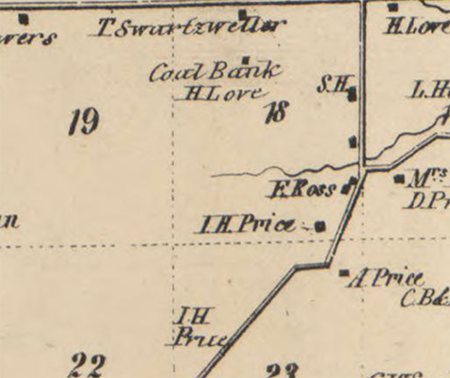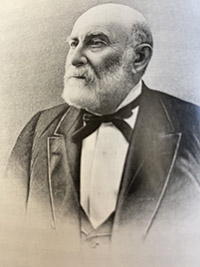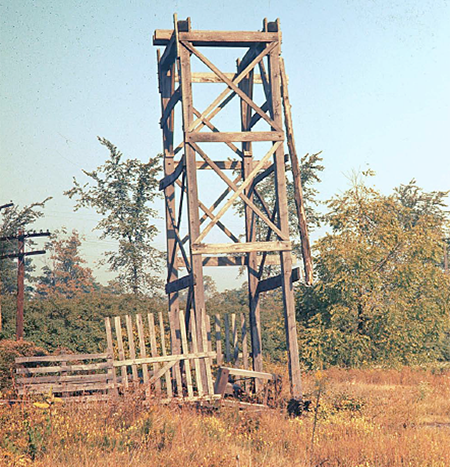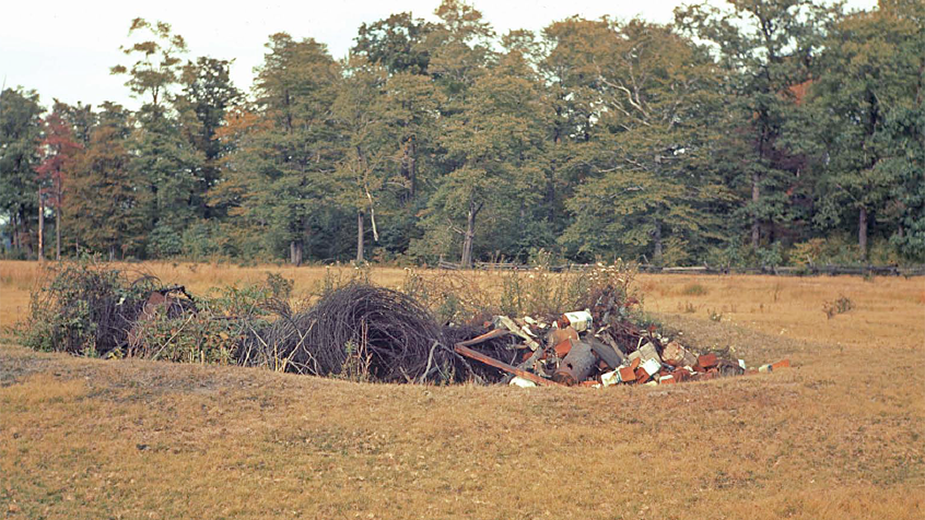HUBBARD – The crossroads at Bell Wick-Campbell and Chestnut Ridge roads in Hubbard Township had its name and destiny written as early as the 1850s.
A map of Trumbull County, printed in 1856, identifies a tract of land in the region just northwest of the city of Hubbard. There, on the property of Hugh Love, is scrawled “Coal Bank” – denoting an outcrop of the industrial fuel that laid the foundation of the boom, and then bust, of this hamlet. Nearly 20 years later, maps show the area had earned a name of its own, replete with its own post office: Coalburg.
More important, the community would exemplify how rapid industrialization in the years following the Civil War laid bare some of the earliest labor tensions in the Mahoning Valley as big business led the drive to cultivate the region’s prized natural resources.
“It appears on official records, but it was never big enough to be a village or town,” Joe Tucciarone, who along with Ben Lariccia wrote “Coal War in the Mahoning Valley: The Origin of Greater Youngstown’s Italians,” says of Coalburg. The earliest published reference to Coalburg (then printed as Coalburgh), he found, came in the Feb. 19, 1868 edition of the Warren Western Reserve Chronicle.

Coal was nothing new in the Mahoning Valley. The mineral was abundant in Youngstown, especially under the Brier Hill farm of George Tod, patriarch of the Tod family. The first mines there, initiated by Tod’s son, future governor David Tod, were picked in the 1840s as the family’s iron interests expanded and the industry’s furnaces transitioned from using hardwoods to coal to fire their operations. As early as 1828, coal seams were also mined at Mt. Nebo in Struthers.
Yet the type of coal buried beneath this section of Mahoning County and southern Trumbull County – often called Brier Hill coal, Sharon coal, or Mahoning block coal – was considered high-quality material because of its soft properties and the higher energy content compared to traditional bituminous coal, Tucciarone says.
Soon, Coalburg was overrun with iron and coal interests owned by industrialists from Youngstown, Niles and Warren. In November 1862, the Cleveland & Mahoning Railroad made public its intention to extend a rail spur to the coal regions in Hubbard Township, instigating a land rush from prominent Youngstown businessmen such as William Powers, Chauncey Andrews and William Bonnell. These landowners then leased the land to companies such as the Mahoning Coal Co. and made a fortune. Farmers, too, signed prosperous lease deals allowing mining on their lands.
By the 1870s the cornfields of Hubbard Township were completely transformed. Coalburg, along with seams of coal found in nearby Liberty Township at Church Hill, collectively became the highest producing coal region in Ohio.
As demand boomed, the industry attracted workers, the majority of them immigrants. The most experienced were miners from Wales, whose families had long histories in Great Britain’s coal industry. Services at early churches, Tucciarone says, were conducted in Welsh Gaelic, not English. In 1865, an accident at a coal slope owned by Madison Powers trapped four miners for several days, underscoring the dangers to which workers were exposed. This accident, along with similar events across the country, inspired agitation for a national miner’s union.
COAL BARONS AND LABOR CLASH
Andrews – Andrews Avenue in Youngstown was named for him – became an especially heavy investor in the coal-bearing properties of Hubbard Township, adds Lariccia, co-author of “Coal War.” He had already made a substantial haul in Youngstown – mining more than 500,000 tons on the Baldwin Farm at Thorn Hill. By 1868, his firm, Andrews & Hitchcock, became the largest coal producer in Ohio. Meanwhile, his interests also turned to railroad development and his activities were such that they attracted the interest of financiers such as Jay Gould. Andrews was also a director of the Mahoning Coal Co.

Lariccia says that miners were not paid hourly, but rather by the ton. In late 1862, Andrews – sensing the plummeting prices in the coal market – made a decision to slash wages by 18%, he says. “The mine operators knew that the coal miners would go on strike,” Lariccia says. Anticipating a walkout, Andrews and other mine owners already had in place a plan to import Black replacement workers from Virginia in his mines in New Lisbon.
“They knew the Richmond, Virginia, area had a lot of coal mines, and opted to attract African-American coal miners,” he says. “They knew the citizens of Trumbull County were not going to be strike breakers.” When the miners struck in January of 1873 – 7,500 of them in the Mahoning and Tuscarawas valleys – the plan was put in motion. The strike made national headlines.
These Black recruits, however, were not told they would be used as replacements until they arrived in Youngstown at the beginning of February. Disenchanted, many of them had joined the striking miners by the end of that month.
Pressed to staff a workforce and the closures having a crippling effect on the iron industry, the mine owners turned to immigrants newly arrived in the United States from southern Europe, specifically Italy, Lariccia says. Lured by steamship companies and ticket agents that promised jobs and opportunity, displaced farmhands from southern Italy began to arrive in the Port of New York at the country’s immigrant station at Castle Garden. “You had all these Italians come in that were promised jobs, but there are no jobs for these people,” he says. “They were swindled.”
It was nevertheless fertile recruiting ground for the Mahoning Coal Co. “About 200 were sent to the Mahoning Valley, first to Coalburg and then to Church Hill,” Lariccia says. These immigrants were also in the dark about the company’s motives and only realized their situation upon their arrival. “They find out and they didn’t have the money to turn back.”
Welsh miners, angered by the arrival of Italians used as strikebreakers, retaliated against the replacement workers and the company, Lariccia says. A short item published in the Holmes County Register dated April 24, 1873, reports that striking coal miners had torched two houses that were properties of the Mahoning Coal Co.
Still, the importation of immigrant workers had its desired effect, Lariccia says. By the end of May, the miners gave in to the mine owner’s demands and accepted the wage cut. Some of the strike leaders were blacklisted by the owners and prohibited work there.
Hostility simmered in the aftermath of the strike and was directed to the Italian community. After a quarrel erupted between a miner and an Italian – Giovanni Chiesa, or John Church – a mob gathered around the boarding house in Church Hill where Chiesa and several Italian immigrants lived. After the mob set fire to the house, Chiesa was beaten to death as he exited.
“He’s the first Italian lynched on U.S. soil,” Lariccia says.
AFTERMATH
The strike and the coal industry had a lasting effect on the greater community, Tucciarone says. Foremost, the arrival of Italian strikebreakers introduced the first Italians to the Mahoning Valley, from which a large community would evolve over the next five decades.

Among those Italians hired as strikebreakers was Fillipo Marcovecchio, a distant uncle of Tucciarone’s, who eventually purchased a house and land in Coalburg where he farmed until his death in 1890. “The name he used was Philip Marquette,” Tucciarone says. “We heard stories that you couldn’t get a job if you were an Italian with an Italian name.”
Tucciarone’s grandfather would purchase a house of his own on what is today Bell Wick Road. The structure, built in 1865, still stands. Meanwhile, many of those Italians displaced from the mining camps eventually found work on the railroads, he says.
By the 1880s, however, the area around Coalburg had been mined out. At its peak, population stood at roughly 800 with “several stores and a thriving place,” according to the “History of Trumbull and Mahoning Counties,” published by H.Z. Williams & Bro., Cleveland, in 1882. By that year, the population had decreased to about 300.
Then, a general store, a Methodist church, a blacksmith, hotel and a post office lined the stretch of Bell Wick Road. All of these structures with the exception of the Methodist church were obliterated as deadly tornadoes swept through the Mahoning Valley in 1985.
As the steel industry expanded its interests, Youngstown Sheet and Tube dammed Little Yankee Run Creek and purchased what is today Coalburg Lake so it could pump water to cool steelmaking equipment, says Mary Lou Reder, today a resident of Coalburg.
Residents who live on the lake have launched a campaign to save it, since the dam – built 100 years ago – has been deemed unsafe. The lake remains privately held and residents want to raise funds to repair the structure and return the lake to its natural splendor.
“One of the big reasons of saving this lake is its history,” Reder says. Coalburg Lake has always resided in private hands – during the 1930s and 1940s, she relates another entity had purchased the land and used it for entertainment. Frank Sinatra is rumored to have performed there, she adds.
Abandoned railroad tracks in and around the lake leading into the dozens of closed mine shafts are still visible in some places, Reder says. The mines have since been filled in.
Tucciarone says when his father was young, he used a ladder from his grandfather’s house and he and his friends descended into one of the shafts. “You could actually still go into those mines in the 1940s,” he says.
Like those mines, the history of the Coalburg strike was buried for years, overshadowed by the larger and violent steel strikes in Youngstown and Warren, Lariccia says. “The Coal Wars – no one really knew about that,” he says.
Pictured at top: A filled shaft of the Mahoning Coal Co. #4 mine in Coalburg. The area of Hubbard and Liberty townships in Trumbull County at one time was the most productive coal mining region in Ohio. Image: Ohio Department of Natural Resources.

